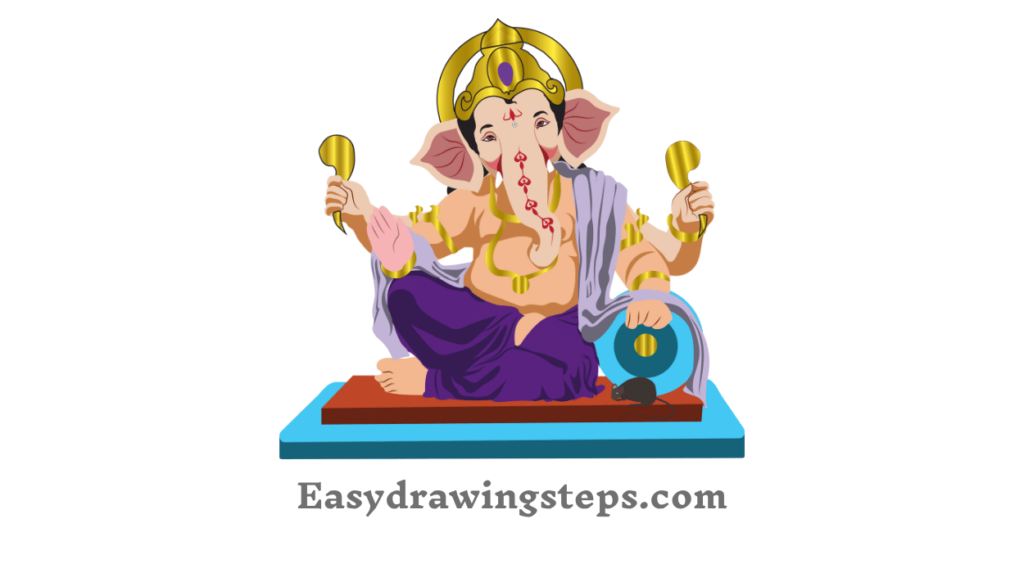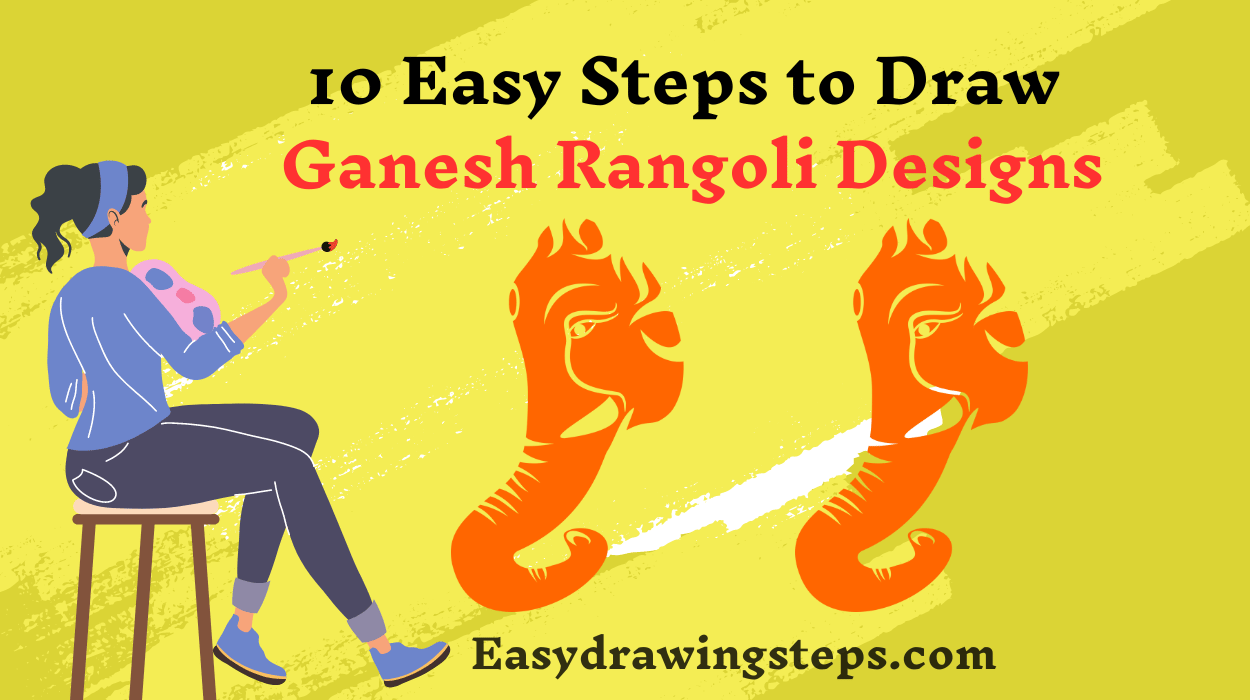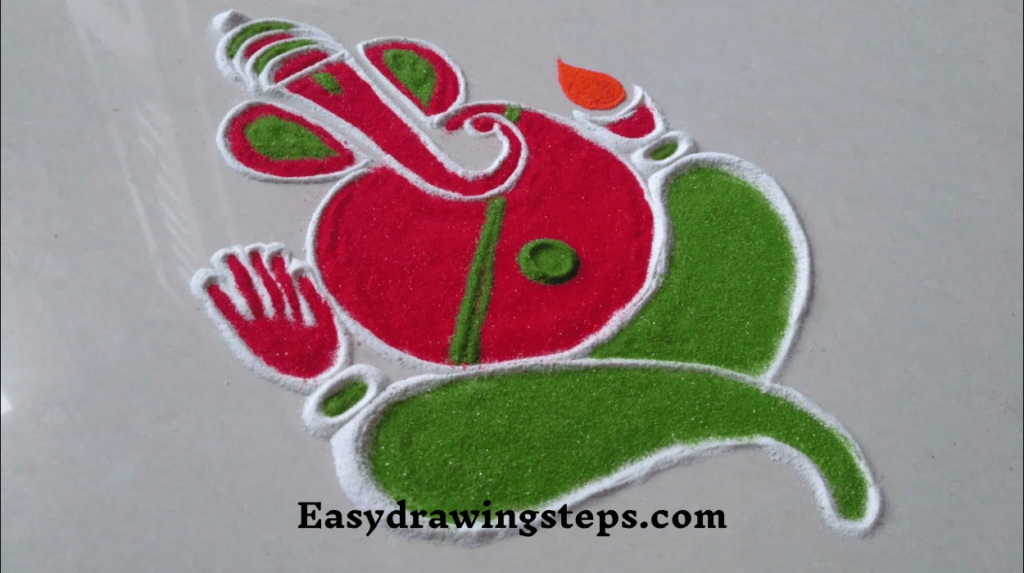Ganesh Rangoli Designs : Ganesh Rangoli designs are a beloved tradition in Indian culture, especially during festivals like Diwali and Ganesh Chaturthi.
The intricate patterns and vibrant colors not only beautify homes but also honor Lord Ganesh, the remover of obstacles and the deity of wisdom and prosperity.
Whether you’re preparing for a competition or decorating for a festival, creating Ganesh Rangoli can be both a creative and spiritual activity. Follow these 10 easy steps to draw Ganesh Rangoli designs, including award-winning designs for competitions, simple designs for Diwali, and patterns featuring Om and Ganesh.
Step 1: Gather Your Materials
To start, assemble your Rangoli-making supplies: colored powders, chalk or a pencil for outlining, a ruler or stencils for accuracy, and a clean, dry cloth for corrections. For Ganesh Rangoli, it’s helpful to have a range of colors including vibrant reds, yellows, greens, and blues to reflect the celebratory nature of the design.

Step 2: Choose Your Design
Selecting the right design is crucial. Award-winning Ganesh Rangoli designs for competitions often feature elaborate patterns with intricate details, while easy Ganesh Rangoli designs for Diwali may be simpler and more accessible. Decide on the complexity of your design based on your skill level and the occasion. Consider incorporating Om and Ganesh symbols if you want to add a spiritual touch to your Rangoli.
Also Read : 10 Easy Steps to Draw Jaswand Rangoli
Step 3: Outline the Design
Begin by outlining the Ganesh Rangoli design on your chosen surface using chalk or a pencil. Start with the central figure of Lord Ganesh, drawing his iconic elephant head and other features. For designs featuring Om, place this symbol strategically around or within the Ganesh figure. Use a ruler or stencils if needed to ensure that the outlines are symmetrical and proportionate.
Step 4: Prepare the Base Colors
Fill in the base colors of your Ganesh Rangoli design. Typically, Ganesh Rangoli designs for Diwali use bright and festive colors. Begin with the main areas such as Lord Ganesh’s face and attire, using colors like red, yellow, and orange. For a more detailed look, blend different shades to add depth and dimension.

Step 5: Add Details to the Ganesh Figure
Once the base colors are in place, add details to enhance the Ganesh figure. Use contrasting colors to highlight features such as the trunk, ears, and the divine symbols on Ganesh’s body. If your design includes Om, fill this symbol with intricate patterns or contrasting colors to make it stand out.
Step 6: Incorporate Patterns and Dots
Ganesh Rangoli designs with dots are a popular choice, especially for their aesthetic appeal and ease of creation. Use dots to form geometric patterns or to outline details within the Ganesh figure. You can create patterns that radiate from the center or frame the Ganesh figure, adding a sense of harmony and balance to the Rangoli.
Also Read : 10 Easy Steps to Draw Ganpati Bappa Rangoli Simple
Step 7: Add Decorative Elements
Enhance your Rangoli by adding decorative elements such as flowers, paisleys, or additional motifs. These elements can fill empty spaces and complement the Ganesh figure. Use colors that contrast with the main design to make these elements stand out and add to the overall beauty of the Rangoli.
Step 8: Review and Adjust
After completing your Rangoli, review the design for any inconsistencies or areas that need touch-ups. Smooth out any uneven color application and make sure the lines are clean and sharp. Adjust any details as needed to ensure that the Rangoli looks balanced and aesthetically pleasing.
Also Read : 10 Steps to Draw Ganpati Rangoli Easy
Step 9: Add Final Touches
To finish, add any final touches to your Ganesh Rangoli. This could include additional highlights, small embellishments, or even a light sprinkle of glitter for added sparkle. Ensure that all elements of the Rangoli are neatly done and that the design is visually cohesive.
Step 10: Maintain and Preserve
To maintain the beauty of your Rangoli, keep the area clean and avoid disturbing the design. If your Rangoli is placed outdoors, consider protecting it from the elements. For indoor Rangoli, gently clean the surrounding area to prevent dust from settling on your design.
Creating Ganesh Rangoli designs is a wonderful way to celebrate festivals and showcase your artistic talents. By following these 10 easy steps, you can craft a Rangoli that is not only visually stunning but also rich in cultural and spiritual significance.
Whether you’re aiming for an award-winning design for a competition or a simple Rangoli for Diwali, the techniques and tips provided will help you achieve a beautiful and meaningful creation. Embrace the tradition, enjoy the process, and let your Rangoli bring joy and vibrancy to your celebrations.
FAQ
What materials are needed to create a Ganesh Rangoli design?
You will need colored rangoli powders, chalk or a pencil for outlining, a clean surface to work on, a plate or bowl for symmetry, and optional stencils for intricate details.
How do you start drawing a Ganesh Rangoli?
Start by drawing a basic outline of Lord Ganesha’s face using chalk or a pencil. This includes a circular head, the trunk, ears, and the crown to create the foundational structure of the design.
What is the easiest way to add details to a Ganesh Rangoli?
After sketching the basic outline, use rangoli powder to add details like the eyes, eyebrows, and the tilak on Ganesha’s forehead. You can use a small sieve or a thin stick to place the powder neatly for intricate details.
How can I make the Ganesh Rangoli more vibrant?
Use bright, contrasting colors for different parts of the design, such as red, yellow, blue, and green. Adding shading or gradients with different tones of the same color can also make the rangoli more vibrant and dynamic.
What are some tips for making a perfect Ganesh Rangoli?
Make sure to outline the design with white rangoli powder to create clean edges. Keep the design simple if you’re a beginner, and use stencils for more complex parts. Practice on paper beforehand to improve precision.



2 thoughts on “10 Easy Steps to Draw Ganesh Rangoli Designs”